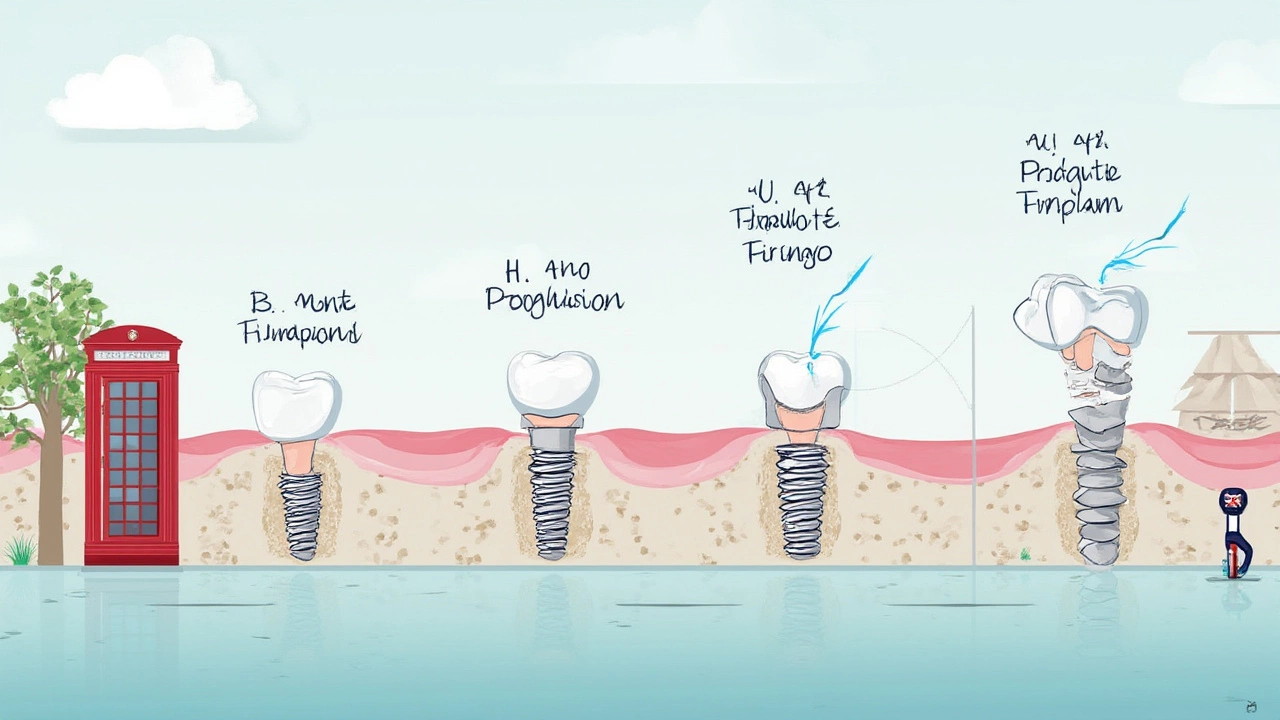Here’s something that’ll make you raise your eyebrows: dental implants, those marvels of modern dentistry, are sometimes called the ‘forever fix’ for missing teeth. But is that just clever marketing or mostly the truth? Loads of folks in Dublin pop into their dentist’s chair hoping tooth implants last for ages, but not many pause to wonder – how long do these little titanium anchors really stick around? If you’re weighing up your options, or maybe you just forked out for an implant and you’re biting your lip over how long it’ll last, you’re not alone.
Let’s cut through the fluff. The idea of a permanent tooth replacement sounds grand. In reality, implants are tough, but like any good investment, their long life isn’t a done deal. Factors like your jawbone’s health, oral hygiene habits, and a sprinkling of luck all play a part. You might be surprised to learn what science says about the real lifespan of dental implants—and the odd quirks that can help an implant outlive its next-door neighbours. Get ready for a straight-talking deep dive that’ll leave you knowing exactly what to expect from your shiny new tooth.
What Exactly Is a Tooth Implant and What Makes It Last?
If you think of a tooth implant as just a fake tooth, you’re missing the magic bit: it’s actually a sort of titanium “root” that gets anchored snug into your jaw, where your natural tooth once lived. Over a few months, your bone grows around this post in a jaw-bone hug dentists call “osseointegration.” This process is what gives tooth implants their near-superhuman ability to stick around for years and handle chewing force like a real tooth. The visible bit – the replacement crown – gets added on top, making it look, feel, and even work much like the original.
But here’s a little-known fact: the actual implant (the titanium bit) is usually the hardiest part of the setup. Most dentists, including specialists right here in Ireland, say implants easily last between 15 and 25 years on average, and plenty stay strong even longer. And yes, there are stories about people with implants still going strong after 30-plus years! The key, though, is that while the implant under your gum is often rock solid, the crown you see and chew with will face wear and tear from daily munching, coffee habits, and those midnight snacks.
Let’s break down what influences longevity in real life:
- Materials used: Modern implants use titanium for the root because it fuses best with bone. Ceramic is sometimes an option for metal allergies. Crowns can be porcelain, ceramic, or metal—each with different lifespans.
- Implant location matters: Implants at the back of the mouth have a tougher job, dealing with stronger chewing forces than those at the front. Molars get the short end of the stick here but can still do well if cared for.
- Bite force and grinding: If you grind your teeth in your sleep (bruxism), you can stress the implant and crown—sometimes more than the system is designed to handle. Night guards help big-time here.
- Smoking and health: Smoking can mess with healing and blood supply in your gums, cutting down the implant’s chances of sticking around. Diabetes, osteoporosis, and uncontrolled gum disease also make things tougher for implants.
There’s no magic bullet, but most modern research puts the success rate for today’s implants at a solid 94-98% after ten years. Not too shabby, right? What you notice, if you look at the numbers, is that failures are far more likely to happen early on, often in the first year, usually because of infection or poor healing—not because the implant simply wore out.
You can see in the data here how impressively dental implants stand up over time:
| Years After Placement | Implant Survival Rate |
|---|---|
| 5 | ~98% |
| 10 | ~95% |
| 15-20 | ~90%-94% |
| 25+ | 80% and above (depends on patient care) |
Of course, those numbers are based on big studies mostly in Europe and the US, but if you’re popping into a local Dublin dentist, it’s a fair bet the odds are similar – provided you tick all the right boxes for care.
The Real Factors That Decide Dental Implant Lifespan
If you wander through any Irish dental waiting room and ask, “How long do implants last?” you’ll hear a dozen different answers. People get attached to the idea that an implant is a guaranteed, permanent fix. But, like a new car, it’s all in how you drive it and look after it. Some people are surprised to learn that the simple stuff—brushing, flossing, regular cleanings—matters as much as high-tech surgery.
Here’s what research and actual dental cases reveal about what really affects an implant’s long-term survival:
- Hygiene habits: Neglect your oral care and you’ll invite peri-implantitis (similar to gum disease). This is the main culprit behind implant failure in the long run. Regular check-ups mean issues get caught early, giving you more years with your implant.
- Bone health: Implants need a healthy, solid base to stay put. If you’ve had gum disease or bone loss, your dentist might do a ‘bone graft’ to build things up. Weak bone means the implant’s foundation is shaky, and that slashes its lifespan.
- Lifestyle choices: As mentioned, smoking, uncontrolled diabetes, and failing to tackle gum disease will land you in the ‘high-risk’ camp for implant loss. Smokers actually face up to twice the risk of losing an implant compared to non-smokers. That’s a big number.
- Age and general health: Implants work well for people both young and old, but older folks sometimes face slower healing. Folks with osteoporosis or autoimmune diseases need careful management, but with today’s options, implants are still a go for most healthy seniors.
- The dentist’s skill: You might not think about it until something goes wrong, but technique counts. Implants placed by an experienced dental surgeon have a clear edge. Dublin has several who specialise in tricky cases, but it’s always worth asking about their track record.
- The bite: A badly-aligned bite can put stress on the implant and the crown, leading to cracks or loosening. Some dentists use digital scans and 3D printing to fine-tune placement now—a big leap versus the old ‘eye test’ approach.
- Type of restoration: Single implants, bridge-supported implants, or even a full arch “All-on-4” system all face different demands. More connections and bigger bridges mean more potential for issues, so the more implants you have, the more you need to watch for maintenance and wear.
In 2023, a large review in the ‘International Journal of Oral & Maxillofacial Implants’ pointed out that 9 out of 10 implants placed more than 15 years ago were still going strong, providing the patients looked after them and visited their dentist at least twice a year. What’s shocking is how quickly things can go wrong if you skip care for even a few years. Infections can set in under the gum or crown and might not give you much warning before things turn serious.
One tip straight from the dental trenches: don’t ignore even tiny chips or cracks in the crown. These create nooks for bacteria and can let bigger problems spiral. Regular checkups usually mean your dentist spots these issues far before they become disasters.
Here’s the big takeaway: if you put in the effort—proper brushing, regular flossing (yes, even around implants), professional cleanings, and skipping smokes—you’ll easily hit that 15- to 25-year window, and likely even longer. If you treat your implant like a spare part, though, you could be back in the chair sooner than you hoped.

When Do Tooth Implants Need Replacing?
This is the sort of thing dentists wish more people asked upfront. Your implant post—the titanium bit—might last decades, but the crown or bridge attached above it will likely need attention at some stage. Crowns are built for battle but not invincible. Most research pegs a crown’s lifespan at around 10-15 years before it’s due for a refresh. A lot depends on how you use it, what you eat, and those sneaky nighttime grinding habits.
Now, if the implant post itself fails (a rare event after initial healing), that’s usually because of either infection, gum disease sneaking in unseen, or severe trauma—think a wallop to the face during a GAA match. More commonly, you’ll face smaller issues: a loose crown, tiny chips, maybe a screw coming loose. Dentists can usually fix these without touching the implant post itself. Like changing the tyres on your car, it’s maintenance, not failure.
But it’s worth knowing the warning signs. If your implant starts to wobble, that’s a red alert. Swelling, bleeding, or pain that won’t quit are also reasons to get it checked immediately. Irish dentists are well-drilled in replacing worn-out crowns, and the beauty of implants is you rarely need to touch the bone-anchored post unless there’s serious trouble. The crown pops off, the post gets checked, a fresh crown goes on, and you’re back to business.
Interestingly, technology keeps pushing things forward. Crowns made from zirconia or porcelain-fused-to-metal offer much stronger biting surfaces now, and digital scanning makes for a better fit than ever. That’s helped extend crown lifespans, with new data showing some bridge crowns lasting up to 18-20 years before swapping.
So, what’s the real-world pattern? Most people with good habits only need their crown replaced once or maybe twice over a typical implant’s lifetime. Full-blown replacement of the implant post is rare, but when it’s needed, it’s usually because of major bone loss or a big infection. That said, cases where a person’s jawbone had kept an implant intact for 30 years aren’t rare now, especially with today’s focus on gum health and regular dental checks.
Spotting little problems before they grow into big ones is the difference between easy maintenance and expensive do-overs. Using a soft-bristled brush, skipping sticky sweets, and investing in a night guard if you grind your teeth at night all go a long way. If you do have to replace the crown, it’s usually a straightforward, pain-free process and doesn’t mean the whole implant failed.
Pro Tips to Maximise Your Dental Implant’s Life
Now for the gold: what can you do to make your tooth implant last as long as possible? It turns out, it isn’t rocket science—but it does take a bit of consistency. Think of your implant as a partnership. Your dentist does half the job; the rest is down to your day-to-day habits.
Here’s a simple set of tips that actually make a difference, straight from the pros in Dublin clinics and beyond:
- Brush twice daily, using a quality electric toothbrush. Pay special attention where the implant meets the gum.
- Floss daily. Special floss or interdental brushes designed for implants can work better than regular string floss.
- See your dental hygienist at least twice a year for professional cleanings and checks. Don’t assume “no pain” means “no problems.”
- If you smoke, consider cutting back or quitting. Your implant (and your general health) will thank you.
- Watch for clenching or grinding, especially at night. If in doubt, get a night guard custom-made.
- Eat a balanced diet—calcium and vitamin D keep your bone healthy, which keeps your implant secure.
- Skip biting down on ice, hard sweets, or opening things with your teeth (yes, people still do this!). These are a fast track to chipping or dislodging your crown.
- Let your dentist know straight away if you spot bleeding, swelling, or a change in how the implant feels. Early fixes save bigger headaches.
One cool trick: keeping a glass of water by your bed and sipping before sleep helps saliva stay flowing at night, which washes away bacteria and helps your implant area stay healthier (especially for older folks who get dry mouth).
Here’s a snapshot comparing simple habits and their effect:
| Habit | Effect on Implant |
|---|---|
| Daily brushing/flossing | Adds 5+ years to lifespan |
| Skipping dental visits | Cuts down success rate by 20% |
| Heavy smoking | Doubles risk of failure |
| Night guard (for grinders) | Reduces risk of cracks by 75% |
The best news? Most of these steps take just a few minutes a day but could mean your tooth implant will still be standing when you’re telling grandkids to brush their teeth. Modern implants offer some of the longest-lasting solutions in all of dentistry. Treat them right, and they might even outlast the rest of your natural teeth.




